The roots of the lawn are happy to have more air. That is why aerating the lawn - also known as aerating - is essential for a lush green.
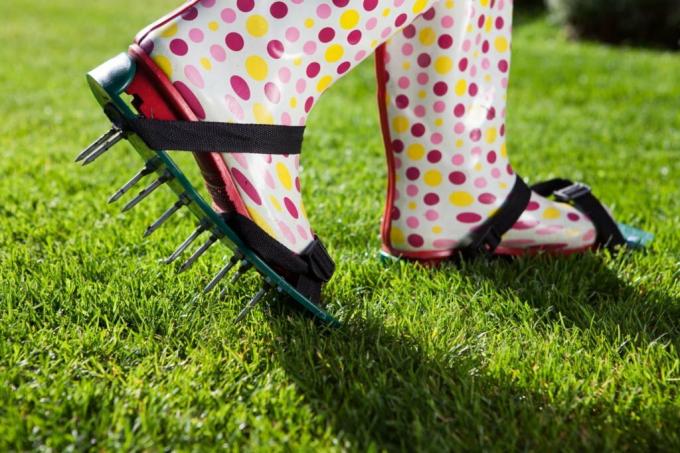
contents
- Why aerate the lawn?
- Aerate or scarify the lawn?
- Aerating the lawn: procedure and options
- When to ventilate the lawn: In spring, summer or autumn?
- Aerating the lawn: advantages
- Aerating the lawn: disadvantages
Intensive care also includes Fertilizing the lawn, Scarifying and Lawn sands among other things also the ventilation of the lawn, the so-called aeration. In the chronological order, ventilation comes after scarifying and before sanding.
Why aerate the lawn?
Every plant wants a well-ventilated and well-drained soil. For this reason, in a vegetable patch you should always avoid stepping in or around unnecessarily. The situation is different when it comes to grass. It serves as a way of playing, as a path to beds and fruit trees and - equipped with garden furniture - as a seating or lying area. Over time, this constant load leads to the fact that compaction develops even in originally well-structured soils. Soils with a high proportion of silt and clay and less sand are particularly at risk of being compacted. For the soil, compaction means that the voids between soil particles, plant roots and Worm channels are compressed more and more and less and less air penetrates into these cavities can. The soil also loses its drainage capacity due to compaction. Water cannot drain off as well and accumulates in the upper soil layers. Moss, lichen and certain weeds feel very comfortable in poorly drained soil, whereas even the best grasses cannot cope well with them. In order to improve the air and water transport in the upper soil layers again, the soil is therefore ventilated or aerated.
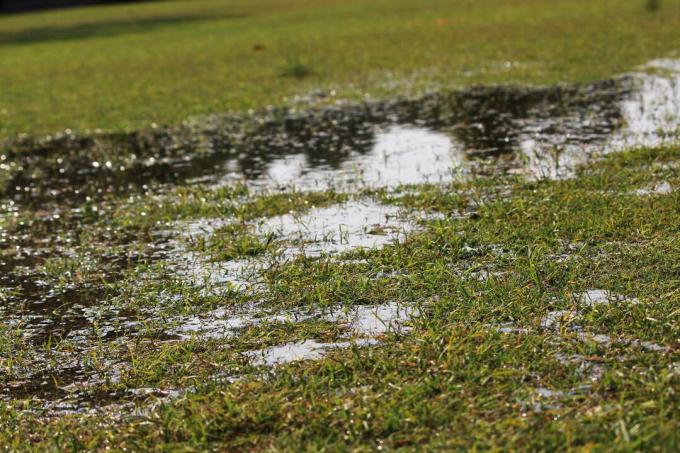
Aerate or scarify the lawn?
Aerating the lawn is not an alternative to scarifying. Scarifying is used to combat moss and felt and is the basis for further maintenance measures. If moss and felt prevent air and water from reaching the surface of the soil, then it will not help the soil either if it is well ventilated. However, there are devices with which scarifying and ventilation can be combined. more on the subject Moss in the lawn learn from this article.
Aerating the lawn: procedure and options
When aerating the lawn, the near-surface soil layer should be pierced in order to improve air and water transport and to stimulate root growth. This is essentially achieved by piercing the ground. Depending on the type of soil and lawn area, different devices are more or less suitable. Piercing with a digging fork can already have a positive effect on smaller areas. When pulling out slowly, the floor is usually lifted a bit and thus slightly loosened and ventilated. Special "spoons", metal cylinders that resemble a digging fork, have more prongs next to each other and thus work more effectively. Rolling lawn aerators also pierce the ground with tines, but do not always have to be pierced and pulled out. They are more suitable for soft, sandy soils.
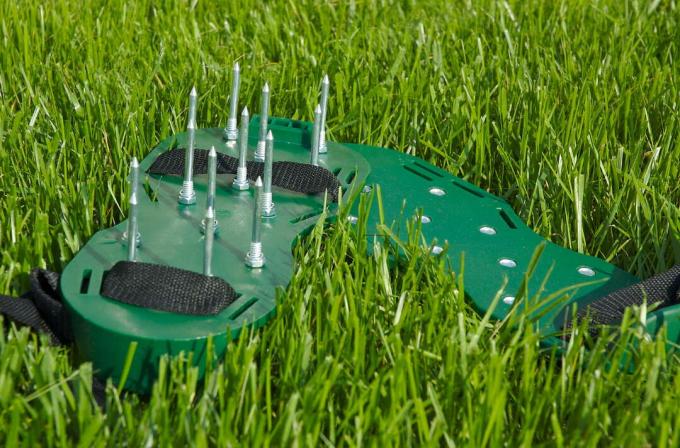
The so-called "hollow spoons" or hollow forks work in the same way as the spoons, but stick out small earth pins from the ground, thereby leaving tubes in the ground. The earth cylinders are then mixed with sand (see Sand the lawn) easily spread over the lawn with a rake. For example, ours is ideal for sanding Plantura Premium lawn sand. This ensures better aeration and water permeability of the soil. In this way waterlogging in the upper soil layers is pre-empted and the load-bearing capacity of the lawn is increased.
There are also hollow forks with a collecting container. In this case, the excavated earth pins can be placed in the vegetable patch, for example, and the earth tubes can be completely filled with sand. This is particularly recommended in soils with very fine, clayey soil and little sand. One way to ventilate small areas with little effort is to use lawn ventilation shoes. These are mostly sandals with nails on the soles. As you walk across the lawn, the nails dig into the ground. These nail shoes ventilate less deeply, but the holes are closer together, which normally increases the success of ventilation. For larger areas there are electrical aeration devices with fan rollers, often machines that combine scarifying and ventilation.
Devices for aerating the lawn: fan roller and Co.
- For manual ventilation on smaller areas: digging fork, spoons, hollow fork or Hollow tines (with or without a collecting basket), rolling lawn aerators
- For ventilation with your feet: lawn ventilation shoes
- For larger areas: Electric aerating devices with fan roller, often combined with a scarifying device
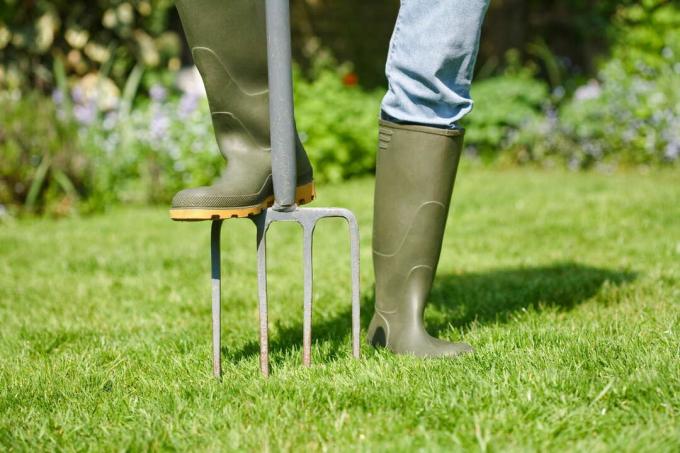
When to ventilate the lawn: In spring, summer or autumn?
The lawn should be aerated after mowing and scarifying take place. When scarifying, the soil surface is opened and mosses and lichens are removed. After scarifying, the uprooted mosses and weeds are removed and the air can already penetrate to the surface of the ground. These are ideal conditions for ventilation. That is why there are now many devices that do scarifying and airing at the same time. But both scarifying and airing place a heavy load on the soil and the grass. That is why dry and hot times, for example, which are already stressful for the lawn, are less recommended for scarifying and ventilation measures. Even cold and humid periods do not give an optimal result. Depending on the weather conditions, a date at the end of May or beginning of June after a few days to a week of drought is ideal. If you want to scarify and / or ventilate a second time, you can do this in a dry week in September, when it is no longer so hot. Depending on the type of soil, it can also be ventilated more frequently.
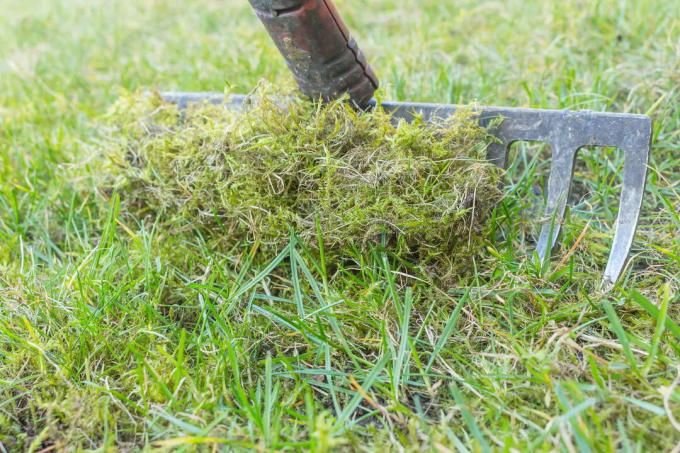
Aerate the lawn: when?
- After scarifying and removing all remains of the scarifying
- Not when it's hot and dry
- Not when it's too cold and damp
- The soil must be absolutely dry
- Late May / early June is ideal
- If necessary a second time in September
Aerating the lawn: advantages
- Walking on the lawn leads to compaction.
- Due to compaction, too little air gets into the topsoil and water is difficult to seep through.
- Moss, lichens and certain weeds are promoted by these conditions, grasses weakened.
- Ventilation or Aeration counteracts soil compaction.
Aerating the lawn: disadvantages
In the case of loamy soils, which are usually particularly badly affected by compaction, ventilation can lead to the puncturing of the hole walls that are firmly smeared and compacted. If this happens, ventilation was either pointless or even counterproductive if the soil and roots are even less aerated due to the hole compaction. This risk can be reduced by ventilating only well-dried soils and sanding after airing with very loamy soils.
Anyone who struggles with moss in the lawn can usually not avoid scarifying. In our special article you can find out when and how often to use the Scarify the lawn should.
